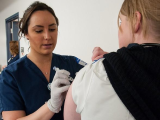Oct 31, 2006 (CIDRAP News) – In a worst-case influenza pandemic, without enough vaccine for everyone, who should stand closer to the front of the line: a 25-year-old water utility worker or a healthy 75-year-old?
Public health officials may have to make difficult decisions such as this, and a Minnesota health ethics group, in publishing recommendations about pandemic vaccine allocation, hopes to get conversations going now, rather than during a crisis.
The vaccine allocation recommendations released last week by the Minnesota Center for Health Care Ethics (MCHCE) look much different from the ones proposed by the federal government. The vaccine rationing recommendation in federal pandemic plan is aimed at saving the most lives, and might favor the healthy 75-year-old over the 25-year-old utility worker.
The Minnesota group's approach is designed to prevent not only deaths due to influenza, but also deaths related to public infrastructure breakdowns. It is weighted toward those whose immune systems are more likely to respond strongly to a pandemic flu vaccine. As such, it would put the 25-year-old utility worker ahead of the 75-year-old.
"The relative priority that the sample plan assigns to different groups offers Minnesotans . . . the maximum chances of surviving both the pandemic and the years immediately thereafter," the report states.
The group said the deadly infrastructure collapse that occurred during the Hurricane Katrina disaster influenced them to seek ways to mitigate other effects of the pandemic, not just the flu deaths. "Seeking only to vaccinate those at high risk of influenza-related mortality leaves them and every other Minnesotan unprotected from death due to breakdowns in basic healthcare, public health, and public safety infrastructures," the report says.
The report emphasizes that approaches to vaccine allocation differ because of different assumptions about pandemic severity. The federal recommendation is based on a moderate pandemic, while the Minnesota group's plan is based on a severe pandemic, like that of 1918-19, along with an inadequate supply of vaccine.
J. Eline Garrett, JD, MCHCE's assistant director for health policy and public health, told CIDRAP News, "To us, it makes more sense to plan for the worst, then adjust the recommendations if the pandemic isn't as severe."
The MCHCE's recommendations assume a W-shaped mortality curve, as seen in the 1918 pandemic, wherein the fatality rate in healthy people aged 15 to 40 is similar to that of small children and elderly people. A more moderate pandemic, like those of 1957 and 1968, has a U-shaped curve, with lowest mortality in young, healthy adults and higher death rates in the youngest and oldest people.
According to the MCHCE's recommendations, those who should receive higher vaccine priority include those with "various combinations" of the following characteristics: high risk for influenza mortality; a strong immune response to vaccination; duty to perform basic healthcare, public health, or public safety roles; a high risk of transmitting the virus to vulnerable groups; or lack of other forms of protection, such as antiviral prophylaxis.
The report says people should have a lower priority if any of the following characteristics apply: natural immunity from having survived the pandemic flu, a low risk of death, likelihood of a weak immune response to the vaccine, or access to other acceptable preventive measures.
"The sample vaccine rationing plan is expected, in effect, to prioritize healthy adolescents and young adults—especially young adults employed in essential service roles—over elderly persons, infants, and persons with comorbidities," the report states.
Early in a pandemic, the plan would assign top priority to key government leaders and vaccinators, followed by essential workers who are at high risk for flu-related death, are likely to respond well to the vaccine, and have no good alternative.
Garrett said singling out who should and shouldn't receive the vaccine can be controversial. The report has drawn considerable media coverage, and Garrett said some people who e-mailed her were critical of the plan's focus on immunizing healthy people. "Vaccine allocation is a complex message that doesn't translate well in a sound bite," she said.
The next step, she said, is to engage the public in discussions about pandemic vaccine allocation.
Jason L. Schwartz, MBE, a researcher at the University of Pennsylvania Center for Bioethics, said the Minnesota group's plan is well reasoned and thoughtful. "Their analysis merits serious consideration," he said.
The federal government, in its pandemic plan, has urged states to take the lead in crafting vaccine allocation strategies, Schwartz said. Though many states mention vaccine distribution in their pandemic plans, few discuss the ethical rationale.
Other experts have recently proposed other vaccine allocation approaches. In May, bioethicists from the National Institutes of Health published a report in Science, suggesting a "life-cycle principle" to guide vaccine allocation. The plan would weight vaccine distribution toward those between early adolescence and middle age, in an attempt to consider the amount people have "invested" in their lives and how long they have left to live.
Schwartz says he expects that states will take a variety of approaches to vaccine allocation. "That's not necessarily a bad thing. We all agree with the core guideline about how can we make most efficient use of tools at our disposal," he said. "We're seeing different solutions because there are so many unknowns."
"If we start wrestling with these issues now, there's a better chance the public will be supportive," Schwartz said.
The MCHCE is an ethics and health policy consortium sponsored by two Twin Cities healthcare systems along with the Sisters of St. Joseph of Carondelet and the College of St. Catherine in St Paul. The report was produced by members of a multidisciplinary Pandemic Influenza Ethics Work Group to guide Minnesota's pandemic planning efforts.
See also:
Minnesota Center for Health Care Ethics recommendations on allocating pandemic influenza vaccines in Minnesota
PubMed abstract
University of Pennsylvania Center for Bioethics vaccine ethics Web site
http://www.vaccineethics.org/
Science article "Who should get influenza vaccine when not all can?"
http://www.sciencemag.org/cgi/content/summary/312/5775/854




















